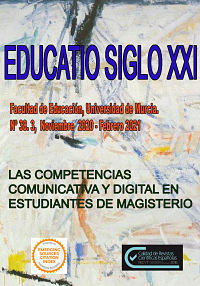Women, society and arts. Collaborative project
Abstract
This paper reports the production of a group book about gender perspectives. Nowadays, the image of women in mass-media tends to be manipulated and this contributes to the dissemination of a misleading and false image of women’s identity. Future teachers should be especially conscious of this situation so that they do not become passive consumers of publicity. This project aims to offer students mechanisms for criticism and reflection to counteract a situation which in the 21st century should be simply unacceptable. Our goal is that our students reflect critically about the role of women in society by means of a collaborative action which this article explains in detail. The capacity of Art to provide images that elicit emotions allows us to reach our aims.
Downloads
-
Abstract751
-
PDF (Español (España))730
References
Adams, J. (2014). Critical Discourses around Participation in Arts Education: iJADE 2013. International Journal Of Art & Design Education, 33(3), 288-290.
Barroso Villar, J. (1995). Aportación femenina de las vanguardias pictóricas vs. Imagen de la mujer en la pintura de vanguardia. En Caramés, J. L. y González, S. (Eds.), Género y sexo en el discurso artístico (pp. 103-113). Oviedo: Servicio de Publicaciones de la Universidad de Oviedo.
Bowman, R. (2011). A Grand Melee of Radical Procedures: Miriam Schapiro on CalArts and the Feminist Art Program. Recuperado de http://www.eastofborneo.org/articles/a-grand-melee-of-radical-procedures-miriam-schapiro-on-calarts-and-the-feminist-art-program
Campos Pardillos, M. Á. (1995). Women’s Lib – Women’s Ads: la mujer como destinataria del discurso publicitario. En Caramés, J. L. y González, S. (Eds.), Género y sexo en el discurso artístico (pp. 155-167). Oviedo: Servicio de Publicaciones de la Universidad de Oviedo.
Carmona, A. (2004). Rosas y Espinas. Álbum de las españolas del siglo XX. Barcelona: Planeta.
Eisner, E. W. (2002). El arte y la creación de la mente. Barcelona: Paidós.
Ellia, L. (2007). Notre combat. París: Seuil.
España. Decreto 105/2014, de 4 de septiembre, por el que se establece el currículo de la educación primaria en la Comunidad Autónoma de Galicia.
España. Ley Orgánica de Educación 2/2006, modificada por la LOMCE 8/2013, de 9 de diciembre.
Franco-Vázquez, C. (2015). La educación visual y plástica en el nuevo curriculum de educación primaria. IBER, Didáctica de Ciencias Sociales, Geografía e Historia, Barcelona, 79(2), 25-32.
Gallego, J. (2013). De reinas a ciudadanas: Medios de comunicación, ¿motor o rémora para la igualdad? España: Aresta Mujeres.
Lorrie, C. (2014). The power of femmage. Recuperado de http://femmage.blogspot.com.es
Marín Viadel, R. (2000). Didáctica de la Expresión Plástica en Educación Artística. En Rico Romero, L. y Madrid Fernández, D. (Eds.), Fundamentos didácticos de las áreas curriculares (pp.153-207). Madrid: Síntesis.
Menéndez Menéndez, Mª I. (2006). El zapato de Cenicienta. El cuento de hadas del discurso mediático. Oviedo: Trabe.
Porqueres, B. (1998). Perspectivas históricas de la situación de las artistas. Arte, Individuo y Sociedad, 10, 199-212.
Rodríguez González, M. A. (2008). De mujeres y máscaras. Lo grotesco y la cuestión del género en el arte actual. SEMATA. Ciencias sociales e Humanidades, 20, 425-443.
Sopova, J. (2011). Entrevista de Michelle Bachelet. El correo de la UNESCO, 2(LXIV), 7-8. Recuperado de http://unesdoc.unesco.org/images/0019/001922/192261s.pdf
Subirats, M. y Brullet, C. (2002). Rosa y azul: la transmisión de los géneros en la escuela mixta. En González, LA. y Lomas, C. (Coords.), Mujer y educación. Educar para la igualdad, educar desde la diferencia (pp.133-168). Barcelona: Graó.
UNESCO, Informe de Seguimiento de la EPT (Enseñanza Para Todos) en el Mundo, ENSEÑANZA Y APRENDIZAJE: Lograr la calidad para todos. Resumen sobre género, 2013/14.
Vignale, F. (2015). Linda Ellia fait du livre d’Hitler une Oeuvre artistique collective. Le MAGE. 28 de septiembre de 2006. Recuperado de http://www.lemague.net/dyn/spip.php?article2474
Zafra, R. (2011). Aprender a ser/aprender a ver. Género y mito en la construcción de imágenes visuales. En Marín Viadel, R. Infancia, Mercado y Educación Artística (pp. 62-76). Málaga: Aljibe.

This work is licensed under a Creative Commons Attribution-NonCommercial-NoDerivatives 4.0 International License.
Original work publishes in this journal is subject to the following terms:
1. Murcia University Press (the publishing house) holds the copyright of the publishes work, and favours and allows their reutilization under the use license stated in point 2.
© Servicio de Publicaciones, Universidad de Murcia, 2015
2. Work is published in the electronic edition under a license (Creative Commons Reconocimiento-NoComercial-SinObraDerivada 4.0 España (legal text). They can be copied, used, disseminated, transmitted and publicly presented, as long as: i) authorship and original publication source is acknowledged (journal, publishing house and URL of the work); ii) are not used for commercial purposes; iii) the existence and specifications of this use license is stated.
3. Conditions for self-archive. Authors are allowed and encouraged to disseminate electronically the pre-pint (before review) and/or post-print (accepted for publication) versions of their work before their publication since that favours earlier circulation and dissemination resulting in an increased chance for the authors to be cited and for the work to reach a bigger share of the academic community. Colour: RoMEO: green.








